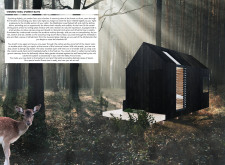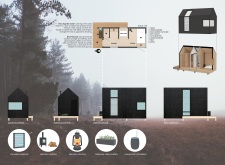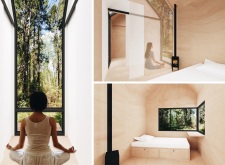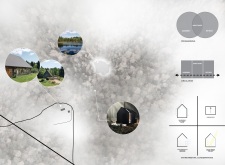5 key facts about this project
Functionally, the structure serves multiple purposes, acting as a retreat for individuals seeking solace in nature as well as a communal space for gatherings and workshops. The thoughtful organization of space promotes tranquility while encouraging social interaction among users. Spaces within the building are designed to facilitate both solitary experiences, such as meditation and reflection, and collective activities that foster community engagement.
The architectural layout of Shinrin-Yoku features dedicated areas that emphasize natural light and views of the forest. The design employs large windows and skylights, which not only allow ample daylight to penetrate the interior but also create a visual connection with the lush greenery surrounding the structure. This connection is crucial in promoting an immersive sensory experience for the occupants, drawing in the sounds and sights of nature.
One of the unique design approaches is the use of traditional and locally sourced materials. The application of Shou Sugi Ban cedar for the building's exterior not only enhances durability against the elements but also establishes a distinctive aesthetic that complements the natural setting. This technique of charring wood originates from Japan and is known for its functionality and beauty. Inside, birch plywood has been utilized, contributing a warm, inviting atmosphere that reinforces the connection to the surrounding forest. The careful choice of materials reflects an understanding of both sustainability and regional context.
Furthermore, architectural elements like louvered windows are incorporated for natural ventilation, allowing fresh air to circulate while maintaining thermal comfort. The project also features a rainwater catchment system, promoting eco-friendly practices that align with the project’s overarching ethos of environmental stewardship.
Special attention has been paid to creating functional landscapes around the building. A personal herb garden not only enriches the site aesthetically but also provides fresh ingredients for communal meals, enhancing the experience of occupants in their interactions with nature. The garden serves as a sensory exploration area, further bridging the relationship between the indoor space and the outside world.
The multi-functional design of the spaces within Shinrin-Yoku allows for versatility in usage. Whether individuals are taking part in relaxing yoga sessions, enjoying group meals, or engaging in workshops, the layout adapts to these varying activities while maintaining an atmosphere of comfort and tranquility. This flexible approach to space ensures that the building can accommodate a diverse range of user needs, reinforcing its significance as a community-focused retreat.
By placing a strong emphasis on sensory experiences, the architecture of Shinrin-Yoku acts as a vehicle for enhancing well-being through nature immersion. This project exemplifies how contemporary design can successfully integrate with its environment, resulting in a place that is not only functional but also meaningful in promoting health and wellness. Those interested in delving deeper into the project's architectural plans, sections, and unique design ideas are encouraged to explore the complete presentation for further insights into this thoughtfully realized architectural endeavor.


























